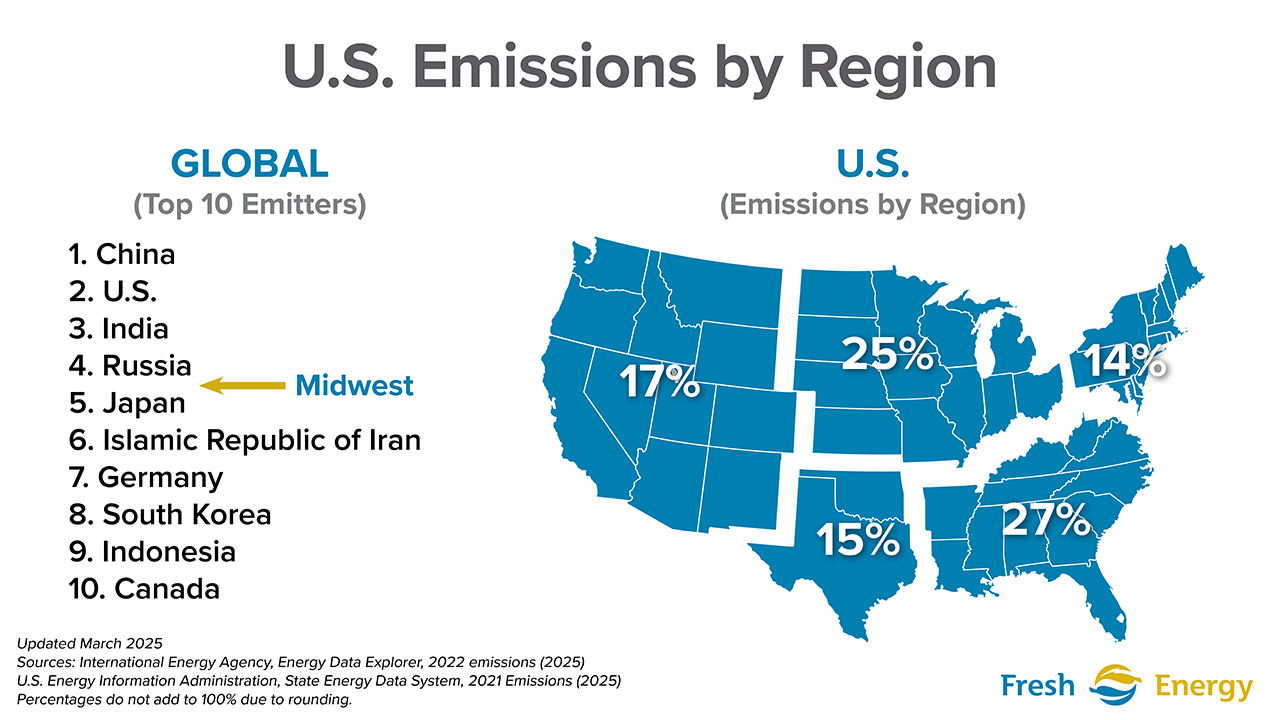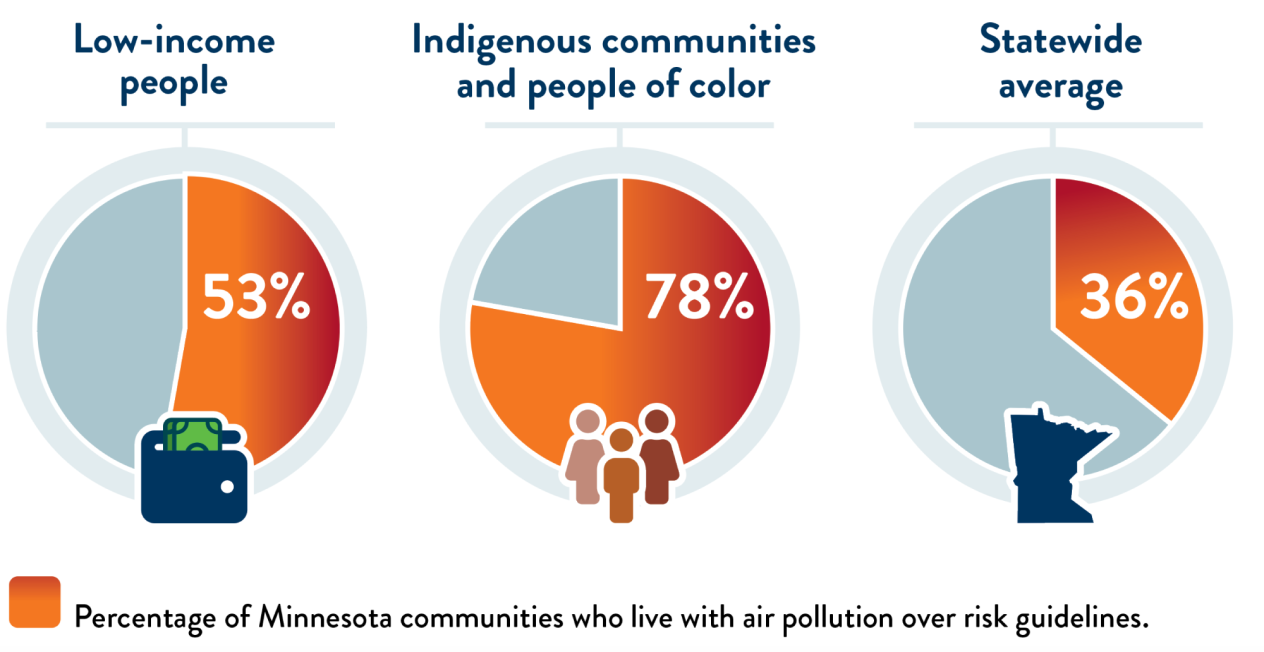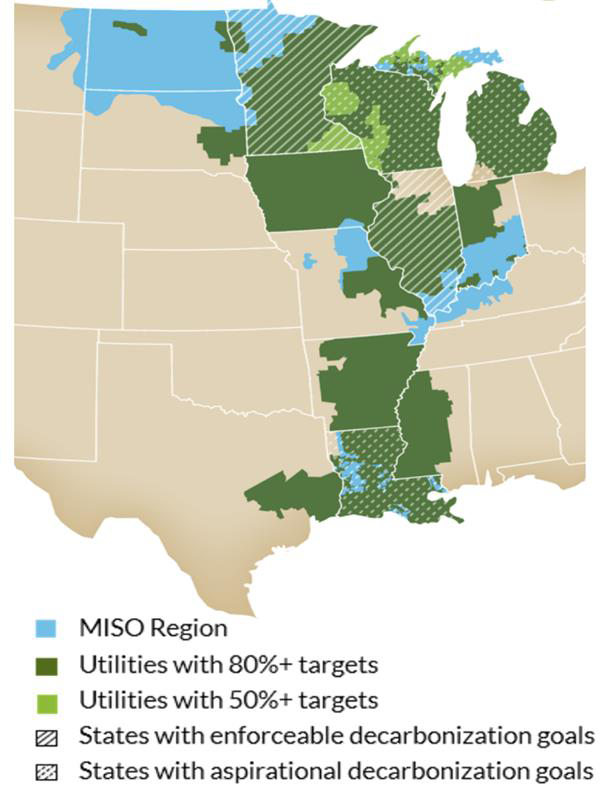
As climate policies advance at every level — from city councils to international summits — many Midwesterners wonder how our region fits into the global fight against climate change. The answer is both simple and sobering: we’re central to the problem. But that also means we’re central to the solution.
The United States leads the world in cumulative GHG emissions, and the Midwest stands as a top contributor to that concerning distinction. To put it in perspective, if the Midwest were its own country, it would rank as the fifth-largest emitter globally. But that means we face immense opportunity to clean up our economy — and make the world a better place in the process.
At Fresh Energy, we’re working alongside partners and clean energy advocates to rapidly and equitably accelerate Minnesota and the Midwest’s transition to a clean energy economy. Understanding where we can make the biggest impact is crucial to our mission. Below, we explore the key reasons why our region holds such significance in addressing the climate crisis.
Midwesterners drive a lot — and rack up more mileage traveling further distances.
The transportation sector is the largest source of greenhouse gases (GHGs) in Minnesota and the U.S. In 2019, vehicle exhaust overtook coal plants as Illinois’ single biggest source of GHG emissions. Similarly, Minnesota’s transportation sector overtook the state’s electricity sector as the biggest source of emissions in 2016. These problems extend across the Midwest. Experts have predicted that what Illinois experienced with its GHG emissions sources in 2019 will be seen in other Midwest states too: fossil fuels are being replaced with cleaner sources of energy to produce electricity — but transportation-related emissions, particularly from on-road vehicles, will continue to rise as the transportation sector lags in switching to zero or low-emission technologies. Similar to the years-long effort made to switch the electric sector off of fossil fuels to cleaner sources, we now need to invest in policies and programs that reduce tailpipe emissions – which is particularly critical to public health and the planet.
Transportation emissions aren’t just bad for our climate — they’re bad for our health. Pollutants from vehicle exhaust span a wide range, from particulate matter (PM), volatile organic compounds (VOCs), and nitrogen oxides (NOx) to other GHGs like carbon dioxide. While their names may seem innocuous, the impact of these pollutants and GHGs on human health when regularly inhaled is dire, posing the greatest concern for youth, the elderly, and under-resourced communities.

Fortunately, electric vehicles (EVs), which have low or no tailpipe emissions serve as a key part of a multi-pronged solution for decarbonizing our economy and lowering GHG emissions in addition to more active transportation forms like walking, rolling, and biking (including e-biking!) and public transit. The EV evolution is well underway, and thanks to decades of work by Fresh Energy and its partners, Minnesota is leading the Midwest in both generating cleaner electricity and using it to power end-use sectors like transportation to decarbonize our economy.
In 2021, Minnesota demonstrated its commitment to transportation that prioritizes cleaner air and healthier communities with the passage of Clean Cars Minnesota, a long-standing Fresh Energy priority, making Minnesota the first state in the Midwest to become a Clean Cars state! But we’re not stopping there.
In tandem with our high-profile clean cars work, Fresh Energy’s policy experts have been pursuing a clean transportation standard and myriad other policy-based solutions for advancing affordable clean transportation of all kinds in the state by working at the legislative, agency, and regional levels to spur progress to electrify transit and school buses, mapping a path to zero emissions for medium- and heavy-duty vehicles, ensuring equitable access to EV charging and electricity rates, and more!
Midwestern electric utilities rely heavily on coal and natural gas — but we’re making great progress
Compared to national standards, the Midwest is disproportionately reliant on fossil fuels like coal and natural gas for generating electricity. When our grid was built, fossil fuel plants like coal were the standard source of electricity generation. Since then, where and how we generate our electricity has changed — with renewables and natural gas replacing coal’s historic dominance on the electricity grid.
Burning coal to generate electricity releases a lot of GHG emissions. And while natural gas emits less CO2 than coal, it’s a potent source of methane, another type of greenhouse gas contributing to the climate crisis. As we’ve replaced coal with cleaner sources — and work to transition all fossil fuels to clean, renewable electricity — we’ve lowered GHG emissions in the Midwest.

The electricity sector is rapidly decarbonizing, and that’s great news for our other economic sectors like transportation, buildings, and heavy industry that will increasingly rely on carbon-free electricity to reduce emissions in their respective sectors through electrification and other carbon-free technologies.
Why is the electricity sector decarbonizing so quickly? First, clean electricity is cheap electricity. Wind, solar, and battery storage have emerged as a low-cost source of electricity. It will take time to replace coal and natural gas power plants — but the queue of electricity generators wanting to connect to the grid is 95% carbon-free sources like wind, solar, and storage. We’re headed in the right direction, and building more clean energy more quickly every year.

Another reason the electricity sector is decarbonizing so quickly is thanks to state policies. Minnesota is leading the Midwest with its 100% clean electricity by 2040 law to ensure our homes, businesses, EVs, and beyond are powered with carbon-free power. Other states are following suit. Illinois has a 100% carbon-free electricity by 2045 law. Michigan has a goal to reach economy-wide carbon neutrality by 2050 through via executive order. Wisconsin has a 100% carbon-free electricity by 2050 via executive order. And Nebraska’s electricity Board set 100% carbon-free electricity by 2040 targets for the state’s three largest publicly owned utilities, which collectively serve 65% of Nebraskans.
The bottom line: States across the Midwest have seen significant growth in electricity generated from renewables as they swap fossil fuels for clean energy, a trend expected to continue as utilities add more megawatts of wind and solar to the grid.
Midwest homes and buildings rely heavily on natural gas for home heating
If you haven’t noticed, it gets cold up here! A large range in seasonal air temperature across the Midwest causes energy demand for both heating and cooling. That’s not surprising, given that 2 out of 3 Minnesotan homes use natural gas for heating.
Heat pumps can help with energy efficiency during cold weather, when energy demand is high. It’s true that the U.S. and states across the Midwest have been turning a corner in electricity generation, having steadily worked to increase usage of carbon-free sources for years. But Minnesota’s commercial and residential building emissions continue to increase — by 48% and 38% since 2005, respectively. Burning natural gas and propane in buildings accounts for about 14 percent of GHG emissions released in the Midwest. In the region’s urban areas, natural gas and propane use in buildings and homes can account for 30 percent or more of GHG gas emissions.
Fortunately, there are numerous programs and policies underway to accelerate equitable and just building decarbonization across the Midwest. Fresh Energy’s Buildings team is working to ensure buildings are resilient and affordable for all, advancing innovative technologies, building systems; forging new pathways to decarbonize the natural gas system; and expanding all-electric buildings through market transformation. From championing ambitious decarbonization policies at the Minnesota Legislature to scrutinizing the natural gas distribution system at the Minnesota Public Utilities Commission, we’re leading the Midwest in decarbonizing our buildings.
Partner organizations are also involved in decarbonizing Midwestern buildings. The Midwest Building Decarbonization Coalition, a non-profit incubated by Fresh Energy, is helping lead that charge. Clean Heat Minnesota is a coalition helping Minnesotans switch their heating, cooking, and power to Midwest-made clean energy.
We’re seeing more and more homes and buildings adopt cold-climate heat pumps as part of their weatherization and energy efficiency updates, which save money, cut GHG emissions, and are an effective solution in Minnesota’s cold climate. By actively engaging with our partners, key stakeholders, and industry, we’re maximizing decarbonization opportunities and driving equitable, transformational change in Minnesota and the Midwest.
The Midwest is an agricultural hub
Often called the “Corn Belt,” it might seem like the Midwestern states (Illinois, Indiana, Iowa, Michigan, Minnesota, Missouri, Ohio, and Wisconsin) only grow corn and soybean as crops. But, in reality, the Midwest offers incredibly diverse agricultural production. There are over 127 million acres of agricultural land in the Midwest. Nearly 75 percent of the area is dedicated to growing corn and soybeans; on the other 25 percent, you’ll find everything from alfalfa, apples, and asparagus to green beans, blueberries, and cabbage to cherries, cranberries, and oats or peaches, plums, pumpkins, and wheat.

Overall, the region serves as one of the most intense areas of agricultural production in the world. And it shows. Agricultural production relies on both direct energy consumption — referring to the use of diesel, coal- or fossil gas-generated electricity, and, increasingly, renewable fuels for agricultural activities — and indirect energy consumption, such as the use of fuels and feedstock, especially natural gas, in the manufacturing of agricultural chemicals such as fertilizers and pesticides.
What’s more, large-scale land use changes like deforestation, soil erosion, and machine- or fertilizer-intensive farming methods that are often used across the Midwest emit nitrous oxide and methane, greenhouse gases that exacerbate the climate crisis. In 2022, 75 percent of U.S. nitrous oxide emissions came from agricultural soil management. And don’t forget about that manure! Manure is waste from livestock (poultry, cattle, horses) that is combined with bedding such as sawdust, wood shavings and/or feed waste to create fertilizer. In 2022, four percent of U.S. nitrous oxide emissions came from manure management alone.
Yet, agriculture is not only economically important to our region but serves as a rich tradition for communities across the Midwest. It has an important part to play in the Midwest’s decarbonization puzzle as we reduce emissions while bolstering rural economies, providing additional revenue streams for farmers, and improving water and air quality.
Fresh Energy is working to advance market-based policies that provide incentives for fuel sources derived from alternative cropping systems with low-lifecycle carbon emissions as well as fuels derived from carbon-free electricity. We’re also establishing Minnesota as a regional and federal model for local production and rural economic development in green fertilizer. We’re ensuring that low-carbon fuel pathways help communities, drive business development, mitigate climate impacts, and advocating for electrifying agricultural processes and developing green fertilizer and green hydrogen. We’re also advocating for incentivizing market development of Sustainable Aviation Fuel, an innovative way to reduce emissions from the aviation sector.
Fresh Energy’s new Heavy Industry and Agriculture team is keeping an eye toward both agricultural productivity and the already-present increase in extreme weather events. Agricultural leaders and communities across the region are seeking to improve soil health and water quality with sustainable agricultural practices while encouraging farmers to enter the emerging carbon economy and approving siting of wind and solar farms — including some that even blend renewable energy generation with agricultural production — across the region’s expansive rural territories.
Looking ahead
One thing is clear: The Midwest is crucial to achieving the country’s climate goals and building the clean energy economy we’re all striving for. Midwestern states like Illinois, North Dakota, and Iowa are leaders in clean energy deployment, and others like Michigan, Minnesota, and Illinois are leaders in the clean energy policy arena. With more communities across the region helping expand the clean energy transition in both rural and urban communities and throughout agricultural, transportation, manufacturing, and buildings sectors, we’re sure to see deep decarbonization accelerate throughout the Midwest this decade.
This progress will require sustained efforts from all of us. Energy policy, public demand for clean energy and clean energy jobs, and customer protection have already played a crucial role in driving the Midwest’s transition thus far, and they will continue to do so. Fresh Energy and our partners and supporters across the Midwest will be there to elevate and advocate for community priorities at every step and in each arena along the way.
